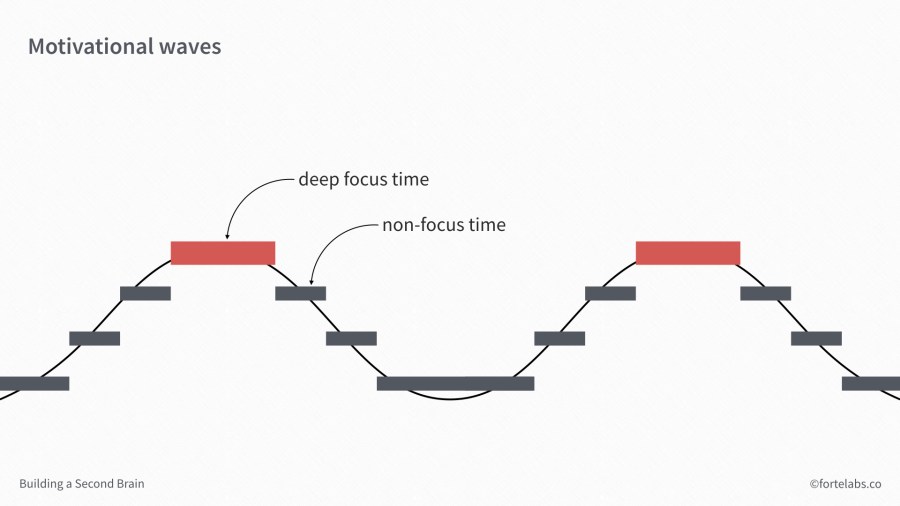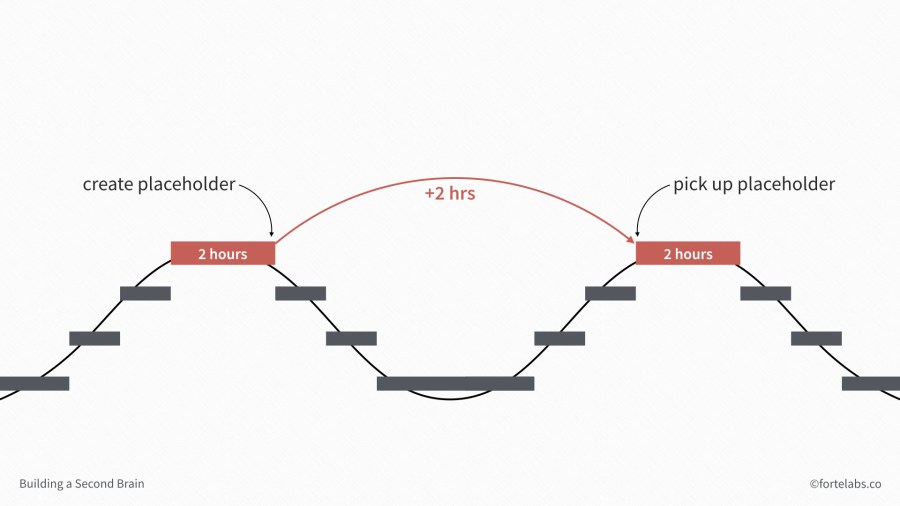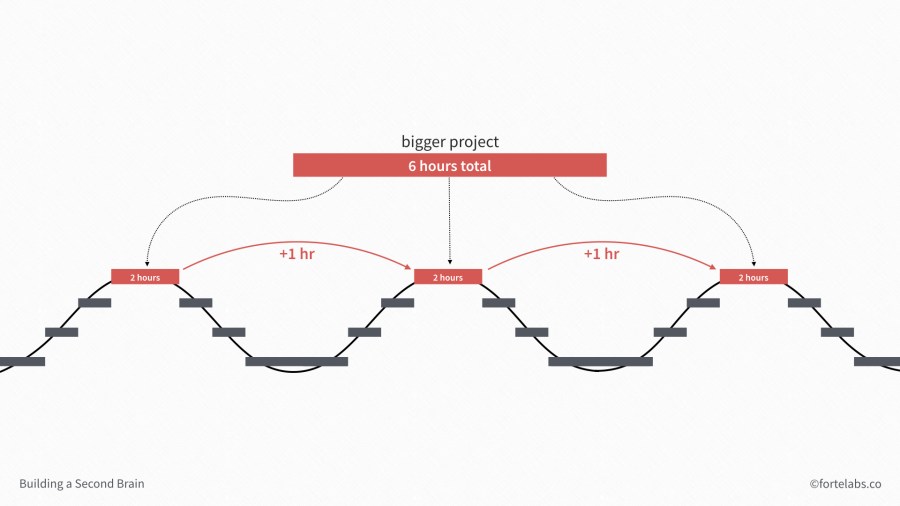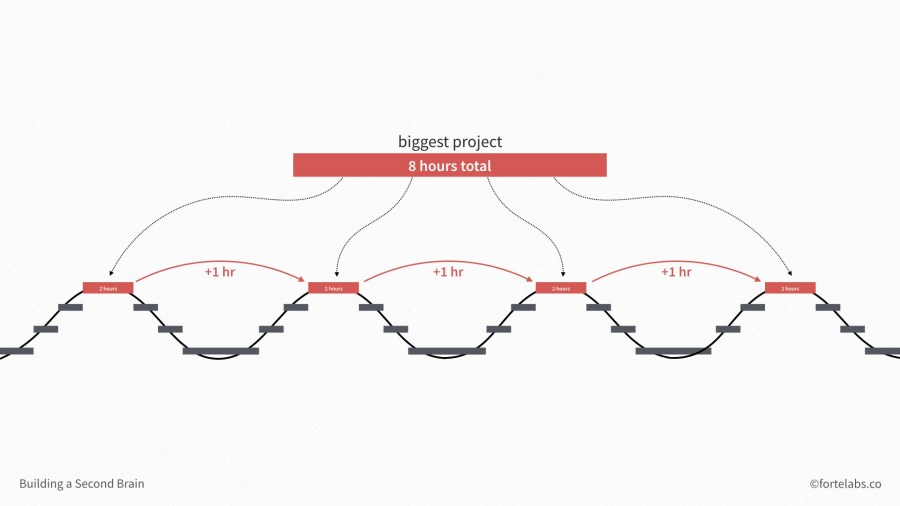
In Part 19, I argued that continuously finding new sources of motivation was the most important challenge for knowledge workers, and that the best way to get started was to generate momentum through a series of small wins.
Although Progressive Summarization can bootstrap you to a minimum level of motivation, at some point you do need to go from faking it to making it. The mind can be tricked, but not fooled for long.
Our challenge goes from motivation to speed: how do you keep the wins coming fast and hard?
Throughout this series, I’ve emphasized again and again the critical importance of speed. Intermediate packets, downscoping, convergence, placeholding, small batches, and other techniques are all designed to help us maintain momentum.
Why is moving quickly so deeply important?
Because information decays. The actual data can be stored on disks or on paper for many years, but the essential value of that information is perishable, on multiple levels:
- Accuracy: accepted facts over time get replaced by newer, more accurate facts, through the normal process of scientific and cultural progress
- Relevance: as conditions change in society and the economy, an idea that was once highly innovative quickly becomes obsolete
- Awareness: as we previously examined, information that has been “loaded up” into our brains gets unloaded as soon as we move on to other tasks
- Memory: on longer timescales, we eventually completely forget that certain information even exists
Understanding that information is a highly perishable product, like fresh fruit or ice cream, the cost of delays starts to become apparent. Like an ice cream delivery truck hitting traffic on the freeway, the cost of a delay is not measured in minutes or hours. A delay risks losing the whole shipment.
Let’s convert our previous diagram from emojis to approximate timespans. Although states of mind vary a lot, all we need to keep in mind for now is that they don’t last forever. The segments in red represent our peak productive times.
If a project is large and requires deep focus, you’ll have to split it across more than one work session, because your deep focus time only happens occasionally:
But that means you have to placehold that project at the end of the first session, and pick up the placeholder again at the next one:
This “maintenance” itself takes time, which increases the total time required for the project, let’s say from 4 hours to 6 hours:
No big deal, right? So what if it takes an extra day?
Not so fast. Spreading the work out over three sessions requires even better placeholders, which take more time to create and pick back up, which means even more maintenance time. Now the process has to be split over 4 sessions instead of 3:
Oh wait, now it’s Friday. We need to make an extra good placeholder to make sure this information survives the weekend intact. Oh now it’s a holiday…do you see what’s happening?
This is a runaway positive feedback loop. No matter how much additional time you add, the proportion dedicated to basic maintenance grows even faster. Any kind of variability in the schedule – from a holiday to a power outage to a teammate out sick, will tend to delay this critical path, because it is deep focus that is most sensitive to interruption.
Before you know it, a project that should be relatively straightforward stretches to months.
In some cases, maintenance eventually consumes all of the effort being expended, and all progress grinds to a halt. You’re left doing nothing but status updates and stakeholder updates and progress reports on a project that is not progressing, which is just about the most demotivating experience imaginable. No one feels responsible nor do they know who to blame, so everyone just sort of gives up, resigned to their fate.
This is the invisible cost of “process.” It is very easy to “add structure” to a project: more planning, more communication, more reviews and approvals, more milestones and subgoals all seem responsible and admirable. No one can be faulted for adding a few additional checkpoints.
But over time these processes add up, like layers of grime. Adding friction at every point of the project slows momentum, which dampens motivation, which further slows progress. Management sees progress slowing and adds even more checks and reviews, which makes the demotivational spiral worse, not better.
Sustained progress is the essential ingredient in escaping this situation. Moving quickly and touching lightly, you can add structure as late as possible and keep it to a minimum, freeing up your time and attention for creating value. This gives you not only profitable projects, but an experience of working that is enlivening and gratifying.
Speed to acceleration
At some point, the challenge shifts once again, from speed to acceleration (and deceleration).
Instead of maximizing speed in a single direction, you cultivate the ability to change speed and direction. Instead of fixing the scope of a deliverable and hammering away at it until it’s done, no matter how long that takes, you continuously modulate the scope as you go along.
Instead of trying to deliver a static product, ignoring how many sessions it takes, you understand the steep cost of delays, and prefer to deliver something smaller but on time. The deliverable you finish at the end of each session becomes a pivot point, a ping you send out to reality that comes back with valuable information.
This isn’t as complex as it sounds. It could include:
- Ending each and every work session with a tangible deliverable, which doubles as an artifact for getting feedback AND a placeholder for picking up later if you need to
- Keeping a prioritized list of features from most to least important, and deciding at the beginning of each work session which ones you will deliver by the end
- Pushing the intensity to finish that last bit of work in the current session, to avoid postponing it to the next one
- Slowing down and doing a thorough job on a small deliverable, rather than starting on a new deliverable you won’t be able to finish in this session
- Only starting new things toward the beginning of work sessions, so you’ll have time to change the scope by the end
- Ending with the (next) beginning in mind, ending your work sessions at a point that’s easy for your future self to pick up on
- Knocking out the major chunks of a project early so you can minimize the later cost of tracking them
- If you can’t make progress in the current work session, then “downshift” to planning and preparation for next working session, to make it easier to get up to speed next time
Follow us for updates on Twitter, Facebook, Instagram, LinkedIn, or YouTube.
The Only Subscription
You Need to
Stay at the
Edge of AI
The essential toolkit for those shaping the future
"This might be the best value you
can get from an AI subscription."
- Jay S.
Join 100,000+ leaders, builders, and innovators

Email address
Already have an account? Sign in
What is included in a subscription?
Daily insights from AI pioneers + early access to powerful AI tools












Comments
Don't have an account? Sign up!